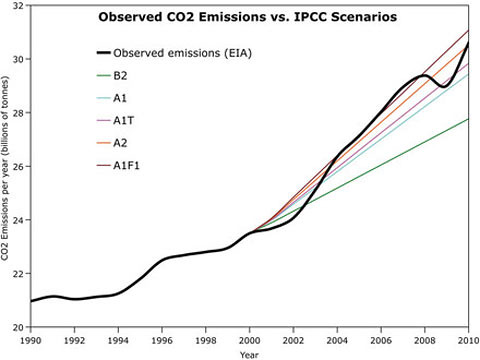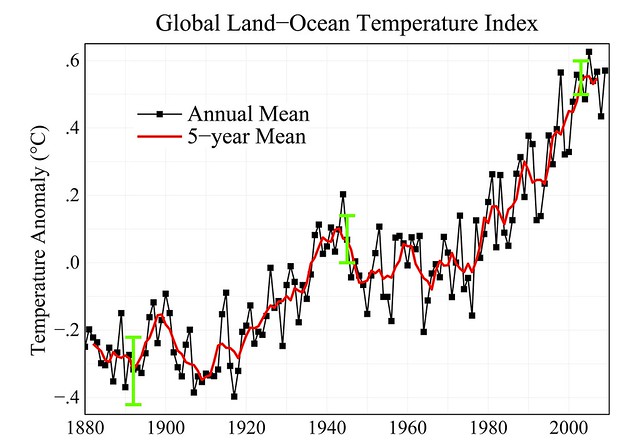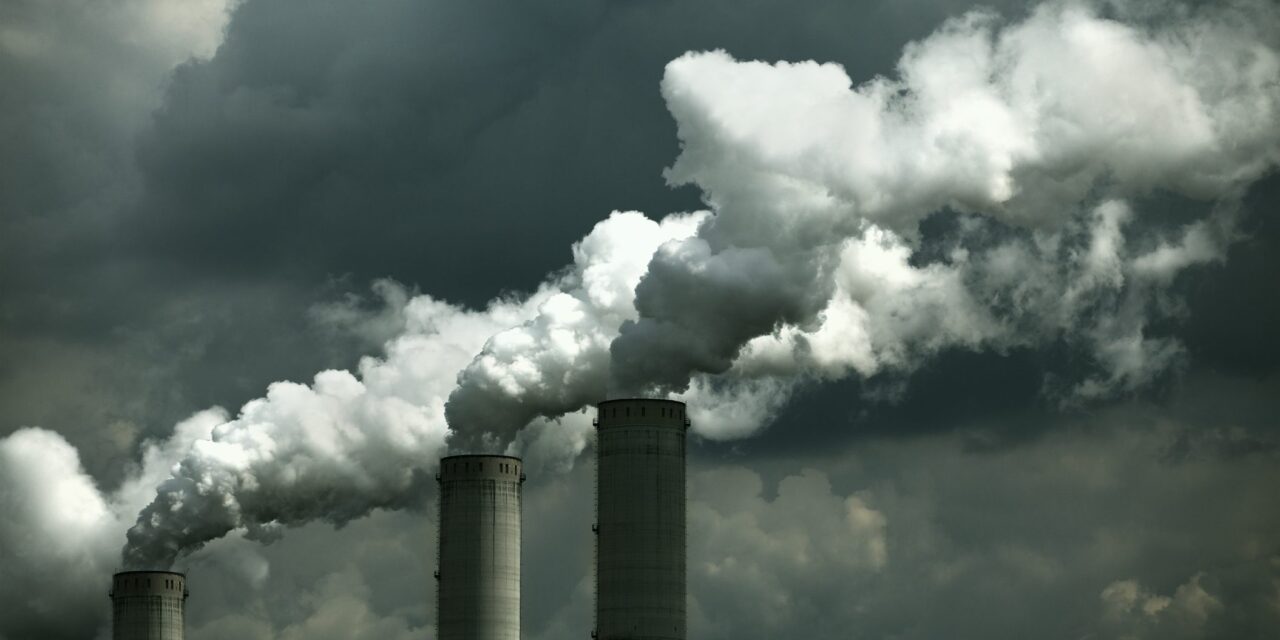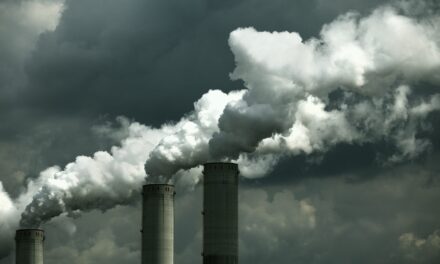That’s what just about every Republican candidate for President and for Congress has to say whether they believe it or not. Sadly, a great many of them probably do believe it. Or they don’t care because they are taking money from the Kochs and Exxons of the world to deny that the massive and ever increasing amounts of CO2 and other greenhouse gases human beings are pumping into the atmosphere doesn’t matter.
Here’s the graph that shows I’m telling the truth about the massive and ever increasing amounts of carbon emissions, by the way:

Here’s another little fact the Republicans will ignore or pooj-pooh. We had the hottest summer in the United States in 75 years this year:
The U.S. has experienced its hottest summer in 75 years, according to USA Today and the National Climatic Data Center in Asheville, N.C. This latest summer season, with an average temperature of 74.5 degrees, has also been recorded as the second hottest ever. Only the Dust Bowl year of 1936, at 74.6 degrees, was warmer.
They will tell you that’s an anomaly. What they won;t tell you is that the worldwide trend in temperatures by decade has increased every decade since the 70’s. The 1980’s were the hottest decade on record until the 1990’s. The 1990’s were the hottest decade on record until the last decade. Here’s the graph that shows the trend in temperatures since 1880:

Republicans don’t like this information being generally known. In fact Republicans in Congress have proposed a lot of bills to limit the EPA’s authority and ability to regulate carbon emissions:
(cont.)
Republicans advanced a $27.5 billion spending bill Thursday that would cut about $2.1 billion in total federal spending, including $1.5 billion from the EPA’s current $8.7 billion in annual budget alone. But the most far-reaching part of the bill has less to do with spending than with giving Congress the upper hand in environmental politics. […]
In addition to proposed spending cuts, Republican appropriators also want to place a cap on the agency’s personnel at the 2010 level, which according to the appropriations committee are the lowest since 1992. But what has Democrats and Republicans most at odds are the provisions dealing with the EPA’s authority on climate issues. Indeed, the bill will dock funding for climate change programs by $83 million, or 22 percent. And there’s a rider—a piece of policy legislation attached to the spending bill—that would prevent the EPA from regulating carbon emissions for power plants and refineries for a year.
The Republicans in Congress also want to gut NOAA’s climate research budget as well, because what the American people don’t know won’t hurt Big Oil. The Republicans have proposed the following:
Prohibiting the National Oceanic and Atmospheric Administration from funding a Climate Service, part of a $338 million cut to NOAA research that would track global warming and monitor the Gulf of Mexico’s health.
Republican voters by a 2-1 margin believe climate change is the result of “natural causes” and is not man made. No wonder Rick Perry and his fellow candidates continue to say that climate science is a sham and that climate scientists are lying:
Perry calls global warming “all one contrived phony mess that is falling apart under its own weight.”
Perry, the putative GOP frontrunner has told even bigger whoppers that that however about climate research:
[T]he Texas governor told an even bigger lie when he said on Wednesday that “trillions of taxpayer dollars” were being spent on climate research, and that climate scientists were “manipulating” information. […]
In response to a question, Perry told voters in New Hampshire:
And the cost to the country and the world of implementing these anti-corbon programs is in the billions if not trillions of dollars at the end of the day. And I don’t think, from my perspective, that I want America to be engaged in spending that much money still on a scientific theory that has not been proven, and from my perspective, is being put more and more into question.
If only. Barack Obama initially budgeted $2.6bn for climate science – the highest allocation for 20 years – and those funds will probably disappear in the debt crisis negotiations. And there has never been any evidence of “manipulation” by climate scientists. In fact, successive inquiries have cleared scientists of wrongdoing.
The only trillions of dollars I know about that the government is shoveling out is going to prop up our rapacious, greedy and incompetent financial institutions. Funny Rick Perry doesn’t mention them, isn’t it? Meanwhile all the allegations that climate scientists manipulated data have been proven false by several independent investigations in the US and the UK.
There isn’t any need to go over all the evidence for climate change caused by global warming, but here’s a few select examples:
On Thursday, the extent of summer sea ice in the Arctic Ocean fell to its lowest level for any Sept. 8 since satellites first began to monitor conditions there in 1979, according to researchers at the University of Bremen’s Institute of Environmental Physics.
Coming so close to the end of the melt season, the observation holds out the prospect that 2011 could replace 2007 as the toughest year for sea-ice survival at the top of the world.
The dip comes on the heels of a record low for the month of July, and August levels that flirted with the 2007 record but did not quite cross the line, according to the National Snow and Ice Data Center in Boulder, Colo.
The data testify to a long-term decline in summer ice underway since at least 1979.
Melting Greenland’s ice fields:
Now, a new study (published online in the Journal of Geophysical Research) has looked at what the satellite data tells us about changes in the Greenland ice sheet between 2002 and 2009 – the data that’s currently available.
They found that Greenland is losing ice overall, although there has been a slight accumulation of ice at the centre of Greenland. The ice loss is particularly severe at Greenland’s edges, with both northwest and southeast Greenland showed an overall decrease in ice mass.
Acidification of Oceans due to Carbon sequestering:
When carbon dioxide (CO2) is absorbed by seawater, chemical reactions occur that reduce seawater pH, carbonate ion concentration, and saturation states of biologically important calcium carbonate minerals. These chemical reactions are termed “ocean acidification” or “OA” for short. Calcium carbonate minerals are the building blocks for the skeletons and shells of many marine organisms. In areas where most life now congregates in the ocean, the seawater is supersaturated with respect to calcium carbonate minerals. This means there are abundant building blocks for calcifying organisms to build their skeletons and shells. However, continued ocean acidification is causing many parts of the ocean to become undersaturated with these minerals, which is likely to affect the ability of some organisms to produce and maintain their shells. […]
Ocean acidification is expected to impact ocean species to varying degrees. Photosynthetic algae and seagrasses may benefit from higher CO2 conditions in the ocean, as they require CO2 to live just like plants on land. On the other hand, studies have shown that a more acidic environment has a dramatic effect on some calcifying species, including oysters, clams, sea urchins, shallow water corals, deep sea corals, and calcareous plankton. When shelled organisms are at risk, the entire food web may also be at risk. Today, more than a billion people worldwide rely on food from the ocean as their primary source of protein. Many jobs and economies in the U.S. and around the world depend on the fish and shellfish in our oceans.
Increase in Droughts and Desertification:
July 2011 was a warm and dry month (fourth warmest and 20th driest, based on data back to 1895) when weather conditions are averaged across the country. But this reflected regional extremes (in both monthly precipitation and temperature) which resulted from persistent weekly regional patterns of precipitation (weeks 1, 2, 3, 4, 5) and temperature (weeks 1, 2, 3, 4, 5) anomalies throughout the month. Hot and dry weather expanded drought in the South, Midwest, and Northeast, and intensified the record drought in the Southern Plains. While earlier droughts are unsurpassed in terms of duration, the current drought in parts of the South is more intense when measured by the Palmer Hydrological Drought Index. USDM statistics rated 61 percent of the Southeast in moderate to exceptional drought at the end of July, while in the Southern Plains 84 percent was rated in moderate to exceptional drought and 47 percent in exceptional drought. The drought was accompanied by dessicated soils, failed crops, and hot temperatures, with more than 2750 daily high temperature records and 6100 warm daily low temperature records tied or broken. These hot temperatures intensified evapotranspiration. “Exceptional” drought (D4) expanded during July, resulting in the largest national footprint of D4 in the 12-year history of the USDM. About 32 percent of the contiguous U.S. was experiencing moderate to exceptional (D1-D4) drought by August 2nd, about four percent more than at the end of June.
– Aid agencies are calling it the worst drought in 60 years. […]
The U.N.’s Office for the Coordination of Humanitarian Affairs (OCHA) is calling it the worst drought the region has experienced the early 1950s. And the problem is made much more difficult by the continuing anarchy and civil strife in most of Somalia, coupled with cross-border raids and violence between pastoral communities in the Ethiopian-Kenyan border.
A senior Chinese official has said it will take 300 years to turn back China’s advancing deserts at the current rate of progress.
Liu Tuo, who leads China’s efforts to tackle the problem, said investment was “seriously insufficient.”
More than one quarter of China is either covered by desert or is land that is suffering desertification.
For decades now mankind has been at the fore in creating a vicious cycle with critical environmental consequences as a result. By degrading the atmosphere with greenhouse gas emissions, land
degradation has risen. This in turn is worsening the
degradation of the atmosphere.Atmospheric greenhouse gas concentrations have been
increasing for some two centuries, mostly a result of
human activities, spearheaded primarily by the rapid
rise of industrialization. The degradation of land,
however, through unviable agricultural practices also
has resulted in emissions of greenhouse gases.
Effect on water and food resources:
Climate Change, Water, and Food Security is a comprehensive survey of existing scientific knowledge on the anticipated consequences of climate change for water use in agriculture.
These include reductions in river runoff and aquifer recharges in the Mediterranean and the semi-arid areas of the Americas, Australia and southern Africa — regions that are already water-stressed. In Asia, large areas of irrigated land that rely on snowmelt and mountain glaciers for water will also be affected, while heavily populated river deltas are at risk from a combination of reduced water flows, increased salinity, and rising sea levels.
Additional impacts described in the report:
An acceleration of the world’s hydrological cycle is anticipated as rising temperatures increase the rate of evaporation from land and sea. Rainfall will increase in the tropics and higher latitudes, but decrease in already dry semi-arid to mid-arid latitudes and in the interior of large continents. A greater frequency in droughts and floods will need to be planned for but already, water scarce areas of the world are expected to become drier and hotter.
Even though estimates of groundwater recharge under climate change cannot be made with any certainty, the increasing frequency of drought can be expected to encourage further development of available groundwater to buffer the production risk for farmers.
And the loss of glaciers – which support around 40 percent of the world’s irrigation — will eventually impact the amount of surface water available for agriculture in key producing basins.
Increased temperatures will lengthen the growing season in northern temperate zones but will reduce the length almost everywhere else. Coupled with increased rates of evapotranspiration this will cause the yield potential and water productivity of crops to decline.
Sound familiar? We’ve made little progress with a Democrat as President and with our brief period of Democratic control of Congress. Imagine now what will happen if Republicans retain control of both the House and Senate. Then imagine if the also regain the Presidency. It’s not just our economic future that will be flushed down the toilet, but any hope that we will do anything to ameliorate the worst case scenario which at the moment is a pretty fricking bad one, a scenario my children and yours will witness within their lifetimes:
(Reuters) – World temperatures could soar by 4 degrees Celsius (7.2 degrees Fahrenheit) by the 2060s in the worst case of global climate change and require an annual investment of $270 billion just to contain rising sea levels, studies suggested on Sunday.
Such a rapid rise, within the lifetimes of many young people today, is double the 2 degrees C (3.6 degrees Fahrenheit) ceiling set by 140 governments at a U.N. climate summit in Copenhagen last year and would disrupt food and water supplies in many parts of the globe.
That’s fifty years from now and I’ll be dead. So will George Bush. We won’t be effected as severely by this looming Epic Fail by humankind. But millions more will die needlessly and billions of others will be immeasurably affected and their lives altered, because we are doing precious little to stave off this catastrophe.
Instead of investing a trillion dollars in green technologies, we are giving it to the same white collar criminals that crashed our global economy. Instead of reducing our dependence of fossil fuels we are allowing Big Oil and Coal (whether in Texas, West Virginia, Pennsyvania, China, Canada, Venezuela or Saudi Arabia) to increase our addiction to the very energy sources that contribute to climate change, but also to the toxic environmental damage from the extraction technologies being employed to obtain those fossil fuels, from producing oil from tar sands, obtaining methane from hydrofracking, or coal from mountaintop removal.
We need jobs. We don’t need large corporations that destroy the environment, make billions in profits and reduce jobs while they ruin our world and our lives.
The oil industry isn’t living up to its billing as a big job creator, congressional Democrats said today.
Led by Rep. Ed Markey, D-Mass., Democrats on the House Natural Resources Committee released a report today that concluded that the nation’s five biggest publicly traded oil companies have been paring their global workforce even as they rake in big profits.
Markey, the top Democrat on the panel, says the findings buck the argument that the oil and gas industry could generate new jobs in America if given greater access to U.S. lands and waters.
“Oil companies that make record profits and then cut American jobs strain their own credibility when they claim to be huge job creators,” Markey said. “Americans are seeing a huge cut of their paycheck go to pay for gas, a little more then goes to fund tax cuts for the same oil companies selling the gas, and then the oil companies take this money and cut American jobs.”
However, green technologies and industries can and does create jobs as well as helping to save our planet.
A group of economists at Economics for Equity & Environment released a study this week that found that reducing emissions, becoming energy independent through clean energy and embracing the green economy would generate net job growth. The study goes on to debunk many of the myths that say reducing emissions and investing in the green economy would hurt the larger economy. A study by the Union of Concerned Scientists came to the same conclusions about the green economy generating job growth, as did a recent study conducted by UC Berkeley that examined the effects that implementing the Global Warming Solutions Act (AB 32) would have on California’s economy.
I’ll let the last word be the people of Appalachia who have already felt the effects of the extraction of coal by any means necessary. What they have to say applies to all the fossil fuel extraction industries
Maybe someone ought to point all these tragedies out to your Republican friends, family members and neighbors. Someone like you. Feel free to email, re-post or otherwise spread the message of this post. Rick Perry, the Tea Party opportunists and the Koch brothers won’t listen, but maybe a few other Republicans will.





